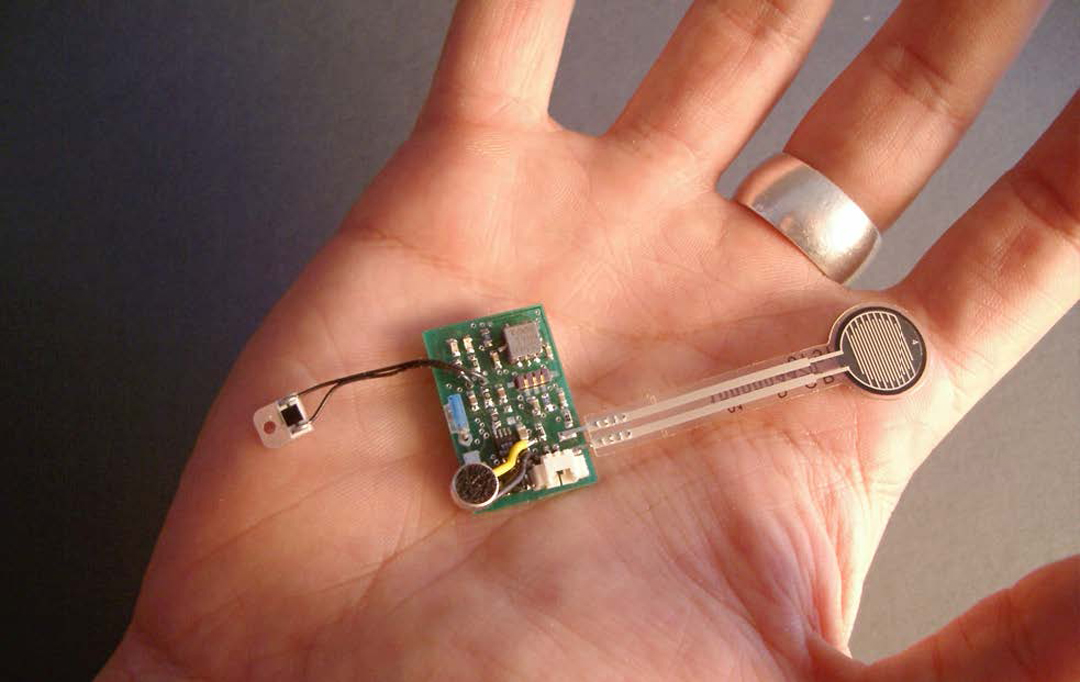“Building Intelligent Environments with Smart-Its” by Holmquist, Gaye, Gellersen, Schmidt, Strohbach, et al. …
Conference:
- SIGGRAPH 2003
-
More from SIGGRAPH 2003:


Type(s):
E-Tech Type(s):
- Adaptive Technologies
- Electronics
Entry Number: 05
Title:
- Building Intelligent Environments with Smart-Its
Presenter(s):
Description:
1 The Smart-Its Platform
The Smart-Its project (www.smart-its.org) develops technology to realize a vision of “computation everywhere”, or ubiquitous computing, where computer technology is seamlessly integrated in everyday life, supporting users in everyday tasks. We approach this vision by creating a class of very small computers, which are equipped with wireless communication and a number of different sensors. By attaching these to everyday objects, it is possible to create “smart” artifacts with very little overhead. Do you need a coffee-cup that knows if it is full or empty, a table that tracks the objects you put on it, or a wine bottle that can tell if it has been stored correctly? No problem – just attach a Smart-It!
A Smart-It consists of a communication board, with a wireless transceiver to let the device communicate with other Smart-Its; and a sensor board, which gives the Smart-It data about its surroundings. The standard sensor board has five sensors: light, sound, pressure, acceleration and temperature. For specific purposes, other sensors can be added, for instance a gas sensor, or even a camera for receiving images. The Smart-Its platform allows designers and researchers to construct responsive or “intelligent” environments with comparably little overhead. There are still no similar toolkits for building this kind of context-aware applications; or even any rapid prototyping tools that can be used to quickly get early test applications up and running. Smart-Its addresses this by presenting a standardized hardware solution, coupled with communication and sensing APIs. This allows for rapid prototyping of advanced interactive applications in a way that has never previously been possible.
2 Smart-Its Application Examples
At SIGGRAPH 2003 Emerging Technologies, we will show how Smart-Its can be used to add communication and perception to everyday objects. One example is using Smart-Its to help assembling a piece of furniture [Antifakos et al. 2002]. By attaching sensors to the unassembled components of a piece of flat-pack furniture, we can determine how the user is progressing. If the user makes an error, she can be informed of this; she can also get continuously updated information about the next step in the assembly process. Another example is Smart-Its embedded in common objects. By attaching Smart-Its with weight-sensors to each corner of a table, it becomes possible to track all objects that are placed on the table [Schmidt et al. 2002]. A similar arrangement with the chairs around the table allows us to track people sitting around the table and their level of activity. The objects on the table may also be augmented with Smart-Its, so that for instance, a jug knows when it is time to refill it, whereas a book knows when it is being read and can turn on a nearby lamp.
3 The Future of Smart-Its Technology
The type of interactive technology that Smart-Its represents is becoming more and more important, from both a commercial and a scientific point of view. A multitude of “smart” consumer products that use sensors and communication in various ways are already in development at research labs in companies and universities all over the world – it is only a question of time before they enter the commercial mainstream. But there has to be several advances before this kind of technology can easily be embedded in everyday objects: the size must go down, as well as cost; power consumption must become significantly lower; application development must be made easier through standardized tools; communication protocols and semantics must be agreed upon to let different artifacts share data; etc., etc. By enabling researchers to quickly build and evaluate smart and context-aware applications, Smart-Its can give us a glimpse of the intelligent environments of the future.
Other Information:
References
ANTIFAKOS, S., MICHAHELLES, F. AND SCHIELE, B. 2002. Proactive Instructions for Furniture Assembly, In Borriello and Holmquist (eds.), Proc. UbiComp 2002, Springer, pp. 351-360.
SCHMIDT, A., VAN LAERHOVEN, K., STROHBACH, M., FRIDAY, A. AND GELLERSEN, H-W. 2002. Context Acquistion based on Load Sensing. In Borriello and Holmquist (eds.), Proc. UbiComp 2002, Springer, pp. 333 – 350.
Acknowledgements:
4 Acknowledgements
Smart-Its is part of the European Union’s Disappearing Computer research program (www.disappearing-computer.net), and financed under EU research contract IST-2000-25428. We would like to thank the partners at ETH, VTT and PLAY for their collaboration.




